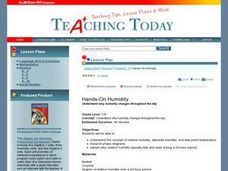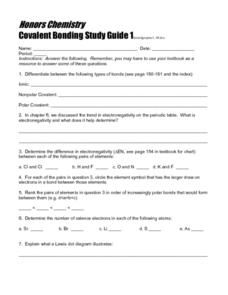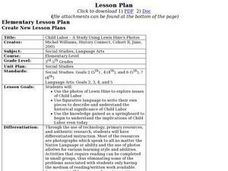Curated OER
Design Your Own Rube Goldberg Machine
Students participate in a culminating activity for a unit on Energy and Simple Machines. They are challenged to incorporate simple machines in to a complex mechanical system. While designing and testing their machine they will also...
Curated OER
To Float or Not to Float, That is the Question?
Ninth graders develop operational definition of density, do computations using density equation, categorize pieces of matter as being able to float on
water or not, based on density, explain why some objects sink or float based on...
Curated OER
Introduction To Digital Camera
Students identify the uses of common computer peripheral devices (printer, digital camera, scanner, LCD display). They incorporate technology into a research project or unit investigation. They work on sizing pictures and putting all...
Curated OER
Population Pyramid
Learners learn about demographic population pyramids. They then design and fictitious nation and draw its population pyramid.
Curated OER
Winogradsky Column Unit
Students are introduced to two changes, physical and chemicl, in order to prepare them to comprehend what changes take place in a Winogradsky Column. They participate in two activities including completion of a worksheet, balloon...
Curated OER
Hinges I, Hinges II
Students use their bodies in daily activities, by promoting a regular routine of using large and small motor skills, personal space, and boundary awareness. They move a scarf to the rhythm of the different kinds of music the teacher...
Curated OER
Vertebrates
Students identify and describe five main groups of the Phylum Chordata. They discover that the Phylum Chordata is the vertebrates. Students identify the main difference between invertebrates and vertebrates. They read passages about...
Curated OER
Who is the Real Roman?
High schoolers describe what everyday life was like in ancient Rome and identify the various classes of people living in ancient Rome. They participate in a game called "The Real Roman," role-playing and trying to convince the class...
Curated OER
Modeling the Change of Seasons
Students evaluate data to determine changes in length of day. They model the revolution of Earth around the sun to show changes in length of day and sun angle and illustrate how the sun angle affects the change of season.
Curated OER
Hands-On Humidity
Students examine why humidity changes throughout the day. They study the concept of relative humidity, absolute humidity, and dew point temperature. They interpret phase diagrams and explain why relative humidity typically falls and...
Curated OER
Exploring the Nervous System Through Disease and Injury
Students are introduced to the nervous system. In groups, they research the relationship between disease and injury and how it affects the nervous system. To end the lesson, they present their findings to the class and create a poster.
Curated OER
Pythagoreum Theorem
Learners practice assessing how to apply the formulas for the area of parallelograms and triangles. They recount the contributions of Pythagoras and apply the theories of the Pythagorean theorem in a group project to calculate the...
Curated OER
Wilson Stands Alone in His Plan for World Peace
Students study the Fourteen Points. They examine motives behind Wilson's Fourteen Points and why most of them were rejected by France. They answers questions concerning primary resources (casualty list and before and after...
Curated OER
Exploring the Exponential Function
Learners collect and analyze data regarding exponential functions of the form y = abx. Students explore the affects of changing parameters on the graph of the function.
Curated OER
Honors Chemistry-Covalent Bonding Study Guide I
In this covalent bonding worksheet, students answer questions about types of bonds, electronegativity, valence electrons, and Lewis dot structures. They answer specific questions about covalent bonds in molecules and explain the...
Curated OER
Satire in Fiction
Twelfth graders identify satire in various fictional texts. For this language arts lesson, 12th graders will learn to define satire, parody, and caricature. Students will identify different forms of satire in historical and modern-day...
Curated OER
Aesop's Fables (Grade 3)
Third graders develop a presentation based on Aesop's Fables. In this Aesop Fables and presentation lesson, 3rd graders examine the characteristics of fables and how to interpret them. They choose one of Aesop's Fables to research. They...
Curated OER
Middle Ages Timeline
Students research a historical figure from the Middle Ages. In this Middle Ages lesson, students present important events of their characters life and of the time. Students write a time card for each significant event. Students must...
Curated OER
Prime & Composite Numbers: Algebra/Geometry Institute 2009
Students create factor trees. For this prime and composite lesson, students model fractions using tiles. They create factor trees and identify prime and composite numbers. Students use grid paper and tiles to model numbers. A...
Curated OER
Alexander Calder: Master of Balance
Students build simple mobiles. For this equilibrium lesson, students investigate the functions of three types of levers as they analyze artwork by Alexander Calder. Students then create their own simplified mobiles.
Curated OER
Mira, Mira on the Wall: Reflections
Learners investigate and perform reflections and symmetry. In this geometry lesson, students compare and contrast the relationship between reflections and symmetries.
Curated OER
Learning Centers for the Middle School Classroom
How to structure and implement learning centers in the middle school classroom.
Curated OER
Comprehension: Setting
Students discuss what setting represents. In this language arts lesson, students review the three elements of setting: where the story takes place, when does the story take place, and is it past, present, or future? Students create a...
Curated OER
Child Labor - A Study Using Lewis Hine's Photos
Students use the photos of Lewis Hine to explore issues of Child Labor. They write their own pieces to describe the historical significance of Child Labor, and show the implications of Child Labor today.

























